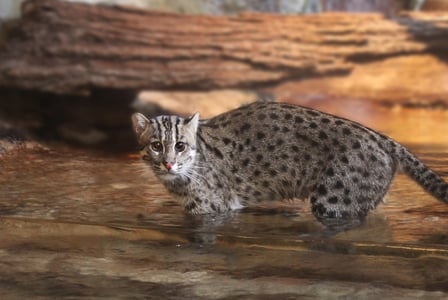
We all know that cats hate water, but it seems that these water-loving felines didnt get the memo! On this Wildlife Wednesday, we learn about fishing cats.
It’s common knowledge that cats don’t like water … but apparently nobody thought to let these water-loving felines know! On this Wildlife Wednesday, we fish up some information about fishing cats.
Habitat
These purr-culiar pussy cats can be found scattered throughout many South Asian counties, including Bangladesh, Cambodia, Indonesia, Nepal, and Sri Lanka. More specifically, expect to see them fishing away in mangroves, swamps and marshes, tidal creeks, and other wetlands with slow-moving water.
Trivia
- As their name not-so-subtly suggests, fishing cats love their fish. So much so, in fact, that it makes up about three-quarters of their diet. The other quarter consists of birds, insects, and small rodents.
- So how would you catch a fish without the convenience of fishing poles and opposable thumbs? Well, fishing cats tap the water’s surface with a paw to mimic the movement of insects and attract hungry fish. Then they dive in to collect their catch.
- Alternatively, they’re also known to scoop frogs and fish out of the water with their partially webbed paws or dive under the water’s surface to launch a sneak attack on unwary waterfowl.
- These sneaky sushi lovers are surprisingly well adapted to their fish-catching lifestyle. Beyond the webbed paws, their curiously short, flat tail can be used as a rudder and their two layers of fur keep them dry, warm, and camouflaged.
Why are they threatened?
The main threat that fishing cats face is the destruction and degradation of their wetland homes. As much as 93 percent of Southeast Asia’s wetlands are thought to be threatened due to pollution, human settlements, excessive hunting and logging, and drainage for increased agricultural space.
The cats are also expected to be greatly affected by unsustainable fishing practices that decrease the availability of their favourite meal, and traps and snares that are left for other animals.


